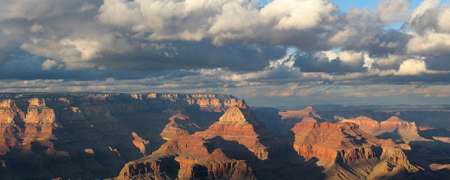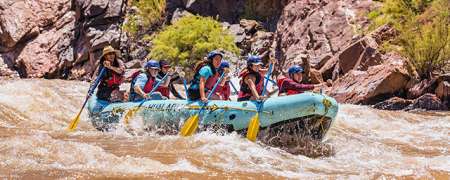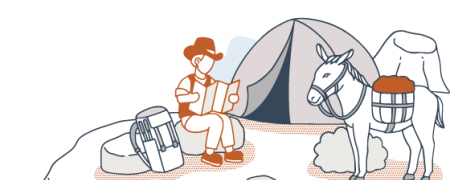Grand Canyon Native American Tribes
Hualapai Tribe
The Hualapai Tribe has inhabited the Grand Canyon Area for hundreds of years, and today has about 2,300 members. Hualapai means "people of the pines" an appropriate name given the large pinyon-juniper forest they historically inhabited during the fall and winter seasons, where they would hunt game and gather pinyon nuts and other edibles. The Hualapai Reservation is located in the Western Grand Canyon and is composed of about 1 million acres of land. Although there is some timer and ranch land, the Hualapai are best known for the Grand Canyon Skywalk which is located on the Hualapai Reservation. Their tribal headquarters in Peach Springs, AZ also operates a hotel and the only one-day whitewater trip in the Grand Canyon. Learn more at the official website of the Hualapai Tribe.
Havasupai Tribe
Havasupai means "people of the blue-green waters" and refers to the beautiful waterfalls of Havasu Canyon which is the tribes home, and their main source of industry, tourism. Supai is the Tribes headquarters and is located 8 miles below the rim of the Western Grand Canyon. All of the supplies for the entire village as well as residents are brought in on a mule, helicopter, or via an 8-mile hike. The Havasupai and Hualapai were at one time a single tribe, who probably split off due to lack of resources. Historically the Havasupai farmed Havasu Canyon during the summer months and hunted game and gathered food along the rim during the rest of the year. Today the tribe has around 400 members. I am the Grand Canyon is a great book about the Havasupai, or you can learn more at the official website of the Havasupai Tribe.
Navajo Nation
With over 300,000 member the Navajo or Dine' Tribe is one of the largest tribes and the largest reservation in North America. The Navajo who first made their way to the southwest over 1,000 years ago, speak an Athabascan based language that originates from the Northwest Territories of Canada, where their ancestors first migrated from. The Navajo were originally hunters and gatherers who adopted farming practices from local Puebloan tribes, and latter cared for livestock. Navajo Traditionally lived in octagonal structures called Hogans, which are still used today. The Navajo Nation is located in Arizona, New Mexico, Colorado and Utah and is composed of 16 million acres. If you are interested in history, Code Talker is a great book about the Navajo Code talkers role in WWII. Today mining, ranching, and tourism are the main industries for the Navajo People, who are well known for traditional art, which includes fine silver and turquoise jewelry, pottery and Navajo Rugs. Learn more at the official website of the Navajo Nation.
Kaibab Paiute Tribe
The Paiute Indians are made up of two groups which have similar languages (of the Uto-Aztecan family and cultures), the Northern Paiute and the Southern Paiute. It is bands of the Southern Paiute that occupy areas around the Grand Canyon in Northern Arizona and Southern Utah. The word Paiute means "the people" and the Paiute name for the Grand Canyon is Kaibab which means "mountain turned upside down". Kaibab is also the name of a band of Paiutes that live close to the North Rim of Grand Canyon National Park. Learn more at the official website of the Kaibab Paiute Tribe.
Hopi Tribe
The Hopi are believed to be the decedents of the ancestral Puebloan tribes who inhabited the four corners area thousands of years ago. The Puebloan tribes were farmers who built amazing cliff dwellings, and other structures of a culture and way of life that mysteriously disappeared. The Hopi Reservation is located in Northern Arizona and is entirely surrounded by the Navajo Reservation. The Hopi village of Oraibi is the oldest continuously inhabited village in the US and has been occupied since at least 1150 AD. Today there are about 7,000 Hopi people who are renowned desert farmers and artists, known for their jewelry, pottery and Kachinas. The Hopi have long been connected to the Grand Canyon, and the Hopi Salt mines located in the Grand Canyon were a destination for Hopi Pilgrims. Also located deep within the Grand Canyon is the Sipapu, a place that the Hopi believe their ancestors emerged from, and an import part of a Hopi Kiva, there center for religious, political and cultural life. Learn more at the official website of the Hopi Tribe.
Zuni Tribe
The Zuni are a Puebloan Tribe who historically inhabited much of the southwestern United States. Today there are about 12,000 Zuni people, most of which live on the Zuni Pueblo, located along the Zuni River in northern New Mexico near the city of Gallup. The Zuni have a unique culture, and the Zuni language is unrelated to any other Native American language. The Zuni are renowned artisans know for pottery, fetishes, and silver smithing. The Grand Canyon has long been a sacred place to the Zuni and Ribbon Falls and Thunder River Falls are still sacred destinations to the Zuni toady. Learn more at the official website of the Zuni Tribe.





